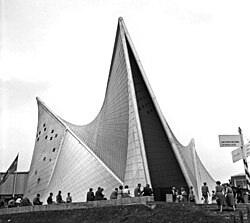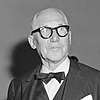Philips Pavilion
| Philips Pavilion | |
|---|---|
 The pavilion at the time of the exhibition, July 1958. | |
 | |
| General information | |
| Type | Pavilion |
| Town or city | Brussels |
| Country | Belgium |
| Opened | 1958 |
| Demolished | 1959 |
| Technical details | |
| Material | Reinforced concrete |
| Design and construction | |
| Architect(s) | Iannis Xenakis |
| Architecture firm | Le Corbusier |
The Philips Pavilion was a World's Fair pavilion designed for Expo '58 in Brussels by the office of Le Corbusier. Commissioned by electronics manufacturer Philips, the pavilion was designed to house a multimedia spectacle that celebrated postwar technological progress. Because Le Corbusier was busy with the planning of Chandigarh, much of the project management was assigned to Iannis Xenakis, who was also an experimental composer and was influenced in the design by his composition Metastaseis.
The reinforced concrete pavilion is a cluster of nine hyperbolic paraboloids in which music, Edgard Varèse's Poème électronique, was spatialized by sound projectionists using telephone dials. The speakers were set into the walls, which were coated in asbestos, creating a textured look to the walls. Varèse drew up a detailed spatialization scheme for the entire piece which made great use of the physical layout of the pavilion, especially the height of it. The asbestos hardened the walls which created a cavernous acoustic. As audiences entered and exited the building Xenakis's musique concrète composition Concret PH was heard. The building was demolished on 30 January 1959.
The European Union funded a virtual recreation of the Philips Pavilion, which was chaired by Vincenzo Lombardi from the University of Turin.
Arseniusz Romanowicz's Warszawa Ochota train station in Poland is supposedly inspired by the Philips Pavilion.
Construction
-
 Floor plan.
Floor plan. -
 13 November 1957, Philip's Pavilion under construction.
13 November 1957, Philip's Pavilion under construction. -
 20 March 1958, Near opening.
20 March 1958, Near opening.
References
Further reading
- Marc Treib, Space Calculated in Seconds: The Philips Pavilion, Le Corbusier, Edgard Varèse, Princeton: Princeton Architectural Press, 1996
- James Harley, Xenakis: his life in music, London: Taylor & Francis Books, 2004
- Richard Jarvis, Music to my Eyes: The design of the Philips Pavilion by Ianis Xenakis, Boston: Boston Architectural Center, 2002
- "The Architectural Design of Le Corbusier and Xenakis" in Philips Technical Review v. 20 n. 1 (1958/1959)
- Joe Drew, "Recreating the Philips Pavilion", ANABlog. January 16, 2010.
- Jan de Heer and Kees Tazelaar, From Harmony to Chaos: Le Corbusier, Varèse, Xenakis and Le poème électronique, Amsterdam: 1001 Publishers, 2017
- Wever, Peter (2015). Inside Le Corbusier’s Philips Pavilion. nai010 publishers. ISBN 9789462082076.
External links
- Film De Bouw van het Philips Paviljoen (Building the Philips Pavilion), a Dutch documentary about the construction project.
- Virtual Electronic Poem Project, a site about a virtual reconstruction of the Philips Pavilion with extensive information about the original site.
- v
- t
- e
- Villa Fallet
- Villa Jeanneret-Perret
- Villa Savoye
- Villa Schwob
- Villa Le Lac
- Planeix House
- Villa Cook
- Maison Guiette/Les Peupliers
- Villa Stein
- Curutchet House
- Maisons Jaoul
- Villa Sarabhai
- Villa Shodhan

- Tsentrosoyuz building
- Notre Dame du Haut
- National Museum of Western Art
- Carpenter Center for the Visual Arts
- Open Hand Monument
- Pavillon de l'Esprit Nouveau
- Pavillon Suisse
- Immeuble Clarté
- Immeuble Molitor
- Cabanon de vacances
- Mill Owners' Association Building
- United Nations Secretariat Building
- Sanskar Kendra Museum
- Museum and Art Gallery
- Secretariat Building
- Palace of Assembly
- Baghdad Gymnasium
- Maison du Brésil
- Church of Saint-Pierre, Firminy
- Firminy-Vert Stadium
- Complexe du Capitole
- Couvent Sainte-Marie-de-la-Tourette
- Maison de la Culture de Firminy
- Usine Claude et Duval
- Governor's Palace
- Palace of the Soviets
- Plan Voisin
- Ville Contemporaine
- Villa Meyer
- Ville Radieuse
- Chaise Longue LC4
- Grand Confort
- Le Corbusier's Furniture
- Poem of the Right Angle (1947–1953)
- Toward an Architecture (1923)
 Commons
Commons Wikinews
Wikinews Wikiquote
Wikiquote
 | This article about a Belgian building or structure is a stub. You can help Wikipedia by expanding it. |
- v
- t
- e
















